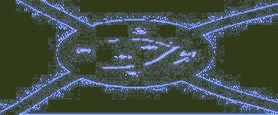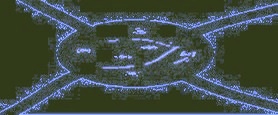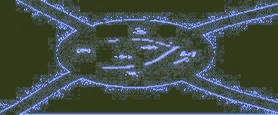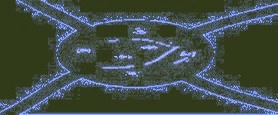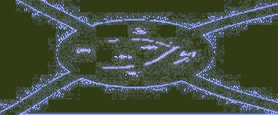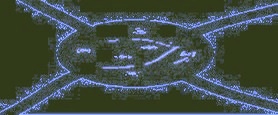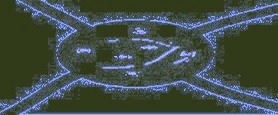Václav Havel died. The powerless one who became powerful and at the same time somehow less powerful than before, has become now powerful in a different way, by doing that thing the dead do - completing a trajectory. Every epochal political event is simple: for instance, the people rise up against their oppressors, a revolution occurs, either violent or "velvet". Except that, like everything else in nature, the simple is also unimaginably complex. Beyond the tipping-point, the event reveals how intolerably multiple it always, in fact, was; discloses the welter of ideas and emotions which fused for an unlikely instant, and then scattered again. Astonishing, that moment of revolt, in its hour and place. How vivid and correct the leader, where there is one, or failing that the multicellular...
Issue 2
An Irregular Magazine More about Junction Box
WARM-UP AND BODY PARTS I step onto the floor. The cool textured plastic of the mat meets my bare soles and I delight in the sensation, my feet still hot from walking up the hill. Adrian comes by and raises his palm to receive a high-five – our traditional greeting. The dojo is still fairly quiet – seven of us are scattered around, warming-up in various states and stages. Some lie motionless whilst others rehearse the vocabulary of yoga or pilates to get themselves stretched-out and limbered-up, whilst a gentle pulsing beat oozes from the speakers. I’m trying to get used to the simple contact between my feet and the floor so I set off on a few experimental steps to test how my balance and weight feels. Even this is enough to threaten to totter me over today, so I bend my knees slightly...
On my wall next to me is a small reproduction of a painting by Dorothea Tanning. It has been in my possession for more years than I can remember. Where I live it lives. I never tire of it but like many fixtures and familiar fittings whole months float by when I don’t see it but merely glimpse its presence. It is cocooned in the most improbable of ornate frames. Gilded flowers, leaves, shells and rococo swirls. A rococo cocoon. Kitsch heaven. The frame alone would give a minimalist a nose bleed. But I’m no minimalist and the extravagance of the frame seems consonant with the reproduction. It is probably Dorothea Tanning’s most famous image but for the life of me I cannot recall its title. Did I ever know it? I suppose I must have once upon a time. As I said, I’ve had it for more years...and...
A BRIEF ACCOUNT OF PERSONAL PRACTICE I was a painter before I was a poet, spending much of my time at school in the art block which was the only modern building and provided a degree of quietness and refuge. I was particularly attached to Expressionism: a Nolde-influenced picture won the Public Schools Art Exhibition prize for oil painting in, I think, 1967. Despite occasional drawing, my energies are now diverted elsewhere. I saw the Hayward exhibition of Nolde’s watercolours in October 1968 and visited Seebüll, the artist’s house in Schleswig, four years later. This was where much of his work was done, including the ‘unpainted pictures’, executed in secret during the years 1941-45 when he was forbidden to paint. Nolde’s work and the surrounding landscape are evoked in ‘Scope’,...
Born July 13.1936 Father of the silent scream. Sweden 1961, playing “Jazz” of un-paralleled intensity. An Afro-American in Sweden 1961. Collaboration with competent time-keepers. Others' material, towing the Jazz party line (J.P.L) Some R&B and blues projects. Soon to realise that within him were more melodies than a human could ever brew. Away with modal padding, the changes, endless conservatoire arpeggios... 1964. Spiritual revolution. Beauty was about to happen. As it was in the beginning so it was in the END. On went the No. 4 white plastic reed onto the Tenor saxophone mouthpiece – maximum vibrato, terrifying pathos. Peace goes on the Attack. The rage of the Horn. Crack the snare drum, sizzle cymbal skid and scuttle of falling bin method,...
Thoughts on recent work by Zoë Skoulding, Susan Howe and Richard Skelton Increasing numbers of musicians are creating works which grasp at the transparency of water, seek to track the journeys of telematic nomads, bottle moods and atmospheres, rub out chaos and noise pollution with quiet, concentrate on sonic microcosms, absorb quotations and digital snapshots of sound into themselves, avoid form in favour of impression, concoct synthetic wilderness in urban laboratories … depict impossible, imaginary environments of beauty and terror. Music that aspires to the condition of perfume, music that searches for new relationships between maker and listener, maker and machine, sound and context. Music that leads the listener into a shifting zone, which Peter Lamborne Wilson has described as...
Written For the Border/Lines 'Orpheus at Glasfryn' Event, 2oth November 2010 I’m not sure what I’m doing here. The Orpheus myth isn’t one I’ve spent much time thinking about. I started by trying to think about that. Some myths I think about a good deal. Why not this one? I’m not sure that it’s not because I don’t like thinking about it. I think I don’t like it for two reasons. Firstly, the story offends me. Orpheus offends me. He lets the poor girl down so catastrophically. And brutally: at the very moment that her freedom – in all the gloriousness of the idea– seems certain. Imagine. It’s unimaginable. The glimmer of reprieve: light, love, normality. The planes of the back and shoulders, moving, just perceptible; the familiar gait. Possibility turning into reality....
In the spring of 2010 Martin Archer began to recruit some Sheffield-based musicians, artists and writers for a choir which could perform part-improvised part-scored music. An inability to sing disqualified no one. He hoped to find 25 voices to create, now and then, a 25-voice chord. This choir – or anti-choir – became Juxtavoices and we occasionally entertain an unprepared but sometimes appreciative or at least intrigued public in unlikely places such as the furnace floor of the old Magna steelworks or the Bear Pit in Sheffield’s Botanical Gardens. It looks as if we’ll be around for some time and perhaps we’ll appear one day in a cave near you. When Geraldine Monk and I went along to the inaugural session we envisaged only contributing our noisy voices although I was curious to...
I was in Greece for six weeks this summer and the reinvention of poverty was very apparent. The English woman running car hire in the next village agreed, there were fewer labourers around, fewer builders. For a few decades Albanians have been the casual labour and skilled house builders in parts of rural Greece. She thought that most had left; Albania was a better prospect now. Then she shrugged and said - Well, Greeks have always had slaves haven’t they, they’ll find some more. This was an uncluttered, plain view of history I thought. Slavery is only one form of economic dominance. We were having this conversation in Messenia, the slave grounds for Sparta.By chance I’d been in Athens when the downgrading of Greek credit worthiness began. I was talking to an Athenian lawyer. ...
In a nutshell, Jim was in for ‘child abuse images’ – what is normally called child porn. There’s a lot of it about – much more than you might think; a click of a button these days and there it is. He didn’t create the images, thank God, he collected them, a lot of them, on his computer at work. It’s surprising how often this is the case. Do such people want to get caught? He wanted to write a novel about his time in the Balkans – Jim had run help convoys to Europe. But he really needed to write about his own life, following on from the self-revelations he’s experienced in the treatment programme he had recently been through. He’d done very well on the programme, broken down, begun to put himself together again. I remember his confusion: How did this all happen? How did...
7th July 2011: Walk west along the beach from Swanbridge to Sully and beyond. This stretch of the Bristol Channel coastline runs more or less east-west. A line drawn from Lavernock Point in South Wales to Sand Point in Somerset separates the Severn Estuary from the Bristol Channel. The coast here, from Lavernock (where it turns north to Penarth and Cardiff Bay) to Barry is a jumble, a hotchpotch. It's a marvellous jumble – a junction of the wild, the industrial and the recreational – but a jumble nevertheless. From the pub at Swanbridge, The Captain's Wife (which dates from the 1970's, despite the forlorn lady in 18th Century costume on the pub sign, bidding farewell to a departing three-master), the going along the beach is initially rough. Opposite the pub, beyond the heap of broken...
This page will be added to over the following weeks. February 25th 2012: ALLEN FISHER, Glasfryn Seminar: The Aesthetics of the Imperfect Fit. See: glasfrynproject.org.uk/w/1274/glasfryn-seminar-with-allen-fisher/ June 7th - 9th 2012: HAY POETRY JAMBOREE: Salem Chapel, Bell Bank, Hay on Wye. Watch this space for further details. Readers so far: Peter Larkin, Ulli Freer, Harriet Tarlo, Andrea Brady, JP Ward, Tony Lopez, Tim Atkins, Jeff Hilson, Caroline Goodwin, Harry Gilonis, Jeremy Hilton, Philip Terry, Nerys Williams, Sophie Robinson, Laurie Duggan, Steven Hitchens, Andrew Duncan, David Greenslade, Keith Hackwood. See also: glasfrynproject.org.uk/w/156/hay-poetry-jamboree/ Out Now: BOILED STRING POETRY CHAPBOOKS SERIES (John Goodby writes): The Boiled String poetry chapbooks...
